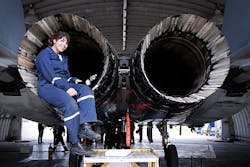Northrop Grumman to develop predictive-maintenance models to anticipate and prevent Air Force airframe cracks
Officials of the Air Force Research Laboratory at Wright-Patterson Air Force Base, Ohio, are awarding $20 million contract to Northrop Grumman for the Airframe Digital Twin (ADT) Spiral 1 program for maintenance, repair, and overhaul (MRO) technology.
The ADT Spiral 1 program seeks to enhance the Air Force's ability to predict airframe problems on different kinds of Air Force aircraft, and conduct preventive maintenance to head-off airframe cracking and other structural problems before they happen.
The program pertains to the aircraft fuselage, wing, empennage, landing gear, control systems and surfaces, engine section, nacelle, air induction, weapon mount, engine mounts, structural operating mechanisms, and other airframe components.
To improve aircraft predictive maintenance, Air Force experts are trying to improve flight loads data, develop more realistic structural analysis models than are available today, and make a concerted effort to quantify and reduce modeling uncertainty over time.
Toward these goals, Northrop Grumman experts in the ADT Spiral 1 program will develop and demonstrate a probabilistic, risk-based, flight-by-flight individual aircraft tracking (IAT) framework to replace the baseline deterministic individual aircraft tracking framework used today for legacy aircraft.
Northrop Grumman experts will attempt to fuse usage and environment data from aircraft on-board sensors; maintenance data collected from the field and depot; and collected maintenance and certification data within physics-based structural prognostic models.
The key part of the program for Northrop Grumman is to integrate three key technologies into aircraft tracking: probabilistic structural reliability analysis (PSRA); on-board and in-situ damage detection; and advanced flight loads simulations.
The overall for Northrop Grumman is to develop and demonstrate a prognostic and probabilistic individual aircraft tracking (P2IAT) methodology that improves the ability to predict fatigue cracking in metal airframes.
The P2IAT approach will integrate advanced flight loads simulation, airframe structural stress analysis, fatigue life analysis, probabilistic structural reliability analysis, and uncertainty quantification methods.
The methodology will improve the fidelity of loads derived from aircraft flight histories to help Air Force maintenance personnel predict airframe problems. The approach will be modular to apply it to different types of aircraft, as well as integrate new analysis models as they are developed.
Related: Lord Corp. C-130 In-Flight Propeller Balancing System completes developmental flight tests
As part of the program, Northrop Grumman experts will demonstrate the effectiveness of the P2IAT approach by tracking fatigue damage in two full-scale structural experiments that simulate flight-by-flight loading.
On this contract Northrop Grumman experts will do the work in Redondo Beach, Calif., and at Wright-Patterson Air Force Base, Ohio, and should be finished by early 2020.
For more information contact Northrop Grumman Aerospace Systems online at www.northropgrumman.com.
About the Author
John Keller
Editor-in-Chief
John Keller is the Editor-in-Chief, Military & Aerospace Electronics Magazine--provides extensive coverage and analysis of enabling electronics and optoelectronic technologies in military, space and commercial aviation applications. John has been a member of the Military & Aerospace Electronics staff since 1989 and chief editor since 1995.
